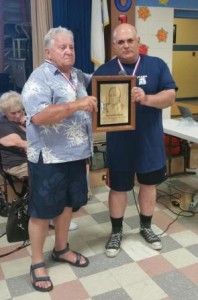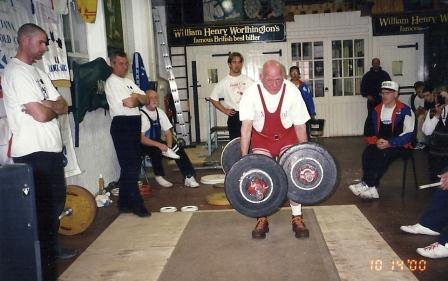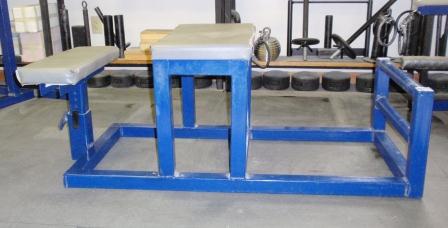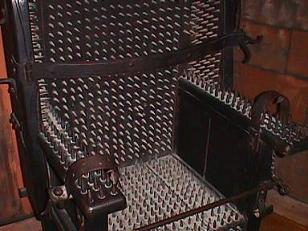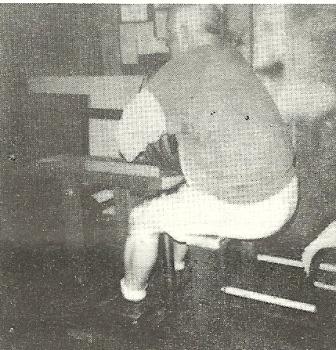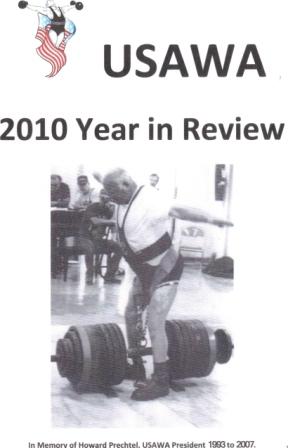by Al Myers
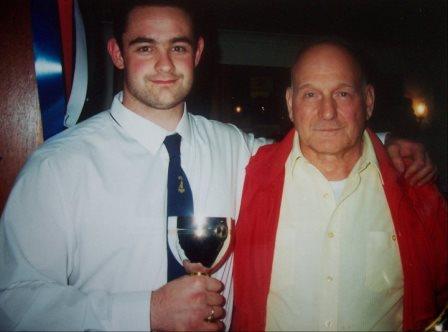
British All Round Champion Steve Angell (left) and Howard Prechtel (right) together at the 1994 IAWA Worlds in Burton-upon-Trent, England.
The 2013 IAWA Gold Cup is coming up this weekend. It is one of three big IAWA promotions (the Worlds and World Postal are the other two). I am really looking forward to attending this prestigious meet hosted by our USAWA President Denny Habecker in Lebanon, PA. Denny has promoted several other Gold Cups and is one of the premier meet promotors in the USAWA – so it, without a doubt, will be a well organized affair.
The Gold Cup is often a misunderstood event, especially if you have never attended it before. I’ve had lifters question me why “go to a meet where you can only do one lift for record?”, especially considering you can potentially set several World Records at a local record day. Let me tell you – the Gold Cup is not like any local record day. The Gold Cup is about the experience of competing in an international event where lifters from several countries will be represented. The direction of the Gold Cup is overseen by the IAWA officers and technical committee to insure that the Gold Cup gives the atmosphere of something very important (which it is!). It allows a lifter to showcase their best lifts on a BIG STAGE for IAWA World Record in front of their IAWA peers. Each lifter and their record lift receives the total attention of those present. When a lifter is performing their Gold Cup lift they have the stage to themselves – and is the only thing going on at the moment. After the meet is over there is always a big banquet to enjoy a great meal, fellowship with other lifters, and have a formal awards ceremony. The banquet is always a highlight for me at the Gold Cup.
Now a little “history lesson” on the Gold Cup:
The first Gold Cup was held in 1991 in Lakewood, Ohio under the direction of Howard Prechtel, IAWA President at the time and originator of the Gold Cup. This year marks the 23rd year of the Gold Cup. In this span the Gold Cup has been promoted every year, without missing a single year. The following came from a 1991 issue of Bill Clark’s Strength Journal outlining Howard’s concepts on the Gold Cup:
On November 23, in Cleveland, Howard will be directing the First Meet Of Champions. The concept is thus: Only people who have won IAWA titles will be invited….a list of some 25 from the USA and England. Each lifter will be allowed to do only one lift of his choice….and he’ll get only one attempt at that lift – which must be a world record. That means only 25 lifts and 25 lifters. Better warm up good – for the TV cameras will take only one look at you. Of the 25 lifters, it looks like we’ll have at least 15 different types of lifts. Howard will be trying a record sit-up, for instance. If you’re a world record holder, but not an IAWA champion, don’t ask. It is a record-makers meet open only to IAWA Champions.
You can see that Howard had a lofty goal originally that this would become a televised feature of All Round Lifting. That never really materialized. Also, you can see that the original criteria for even entering the Gold Cup was pretty strict. Things have evolved with the Gold Cup since then, but there still are entry criteria. For the past few years this has been the main rules regarding entry into the Gold Cup:
1. Lifter must open on their first attempt at an IAWA World Record lift. However, a lifter is given three attempts to repeat an attempt or increase the poundage.
2. To enter the Gold Cup, the lifter must be a current holder of an IAWA World Record.
3. The lifter must be a member of the IAWA, or a member in an affiliated organization of IAWA.
If a lifter can not accomplish a World Record in any IAWA lift, an entry can still be approved. It is of the IAWA philosophy now that NO LIFTER be denied the opportunity to compete in this event. The offering of a Silver Cup Award (for setting a National Record) and the Bronze Cup Award (for a lifter setting a personal record) has been added to allow for this.
You may wonder how that FIRST EVER Gold Cup turned out. Of the 34 lifers that were invited (yes – the first year this meet was by invitation only), 31 entered. All 31 lifters were successful setting new IAWA World Records. As for Howard, it turned out well for him in the success of the promotion and with his quest of setting a new record. The following report from the Strength Journal sums up Howard’s day quite nicely:
After all the effort and money Howard put into the meet, he was the final lifter. He attempted to break an 85-year-old mark in the Travis Lift by doing 60 reps in 60 seconds with 1510 pounds. Travis had done 56 reps in 60 seconds with 1500 pounds in 1906…when he was a young man. Howard, at 66, hardly qualifies as young (except at heart), but he banged out 45 reps with the 1510 in 60 seconds….easily a new IAWA record.
I would truly encourage all all-rounders to try to make it to a Gold Cup. Once you go once, you will understand why I think it is an elite type competition. You meet the “legends” of the sport, and get to see world class all rounders perform their best lifts for World Records.
